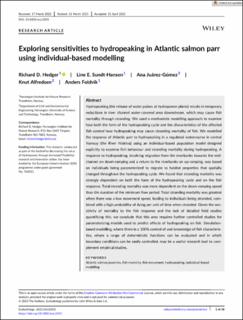| dc.contributor.author | Hedger, Richard David | |
| dc.contributor.author | Sundt-Hansen, Line Elisabeth Breivik | |
| dc.contributor.author | Juarez-Gomez, Ana | |
| dc.contributor.author | Alfredsen, Knut Tore | |
| dc.contributor.author | Foldvik, Anders | |
| dc.date.accessioned | 2023-11-14T12:01:33Z | |
| dc.date.available | 2023-11-14T12:01:33Z | |
| dc.date.created | 2023-04-25T15:35:28Z | |
| dc.date.issued | 2023 | |
| dc.identifier.issn | 1936-0584 | |
| dc.identifier.uri | https://hdl.handle.net/11250/3102441 | |
| dc.description.abstract | Hydropeaking (the release of water pulses at hydropower plants) results in temporaryreductions in river channel water-covered area downstream, which may cause fishmortality through stranding. We used a mechanistic modelling approach to examinehow both the form of the hydropeaking cycle and the characteristics of the affectedfish control how hydropeaking may cause stranding mortality of fish. We modelledthe response of Atlantic parr to hydropeaking in a regulated watercourse in centralNorway (the River Nidelva) using an individual-based population model designedexplicitly to examine fish behaviour and stranding mortality during hydropeaking. Aresponse to hydropeaking, involving migration from the riverbanks towards the mid-channel on down-ramping and a return to the riverbanks on up-ramping, was basedon individuals being parameterized to migrate to habitat properties that spatiallychanged throughout the hydropeaking cycle. We found that stranding mortality wasstrongly dependent on both the form of the hydropeaking cycle and on the fishresponse. Total stranding mortality was more dependent on the down-ramping speedthan the duration of the minimum flow period. Total stranding mortality was greatestwhen there was a low movement speed, leading to individuals being stranded, com-bined with a high probability of dying per unit of time when stranded. Given the sen-sitivity of mortality to the fish response and the lack of detailed field studiesquantifying this, we conclude that this area requires further controlled studies forparameterizing models used to predict effects of hydropeaking on fish. Simulation-based modelling, where there is a 100% control of and knowledge of fish characteris-tics, where a range of deterministic functions can be evaluated and in whichboundary conditions can be easily controlled, may be a useful research tool to com-plement empirical studies. Atlantic salmon juveniles, fish mortality, fish movement, hydropeaking, individual-basedmodelling | en_US |
| dc.language.iso | eng | en_US |
| dc.publisher | John Wiley & Sons Ltd | en_US |
| dc.rights | Navngivelse-Ikkekommersiell 4.0 Internasjonal | * |
| dc.rights.uri | http://creativecommons.org/licenses/by-nc/4.0/deed.no | * |
| dc.title | Exploring sensitivities to hydropeaking in Atlantic salmon parr using individual-based modelling | en_US |
| dc.title.alternative | Exploring sensitivities to hydropeaking in Atlantic salmon parr using individual-based modelling | en_US |
| dc.type | Peer reviewed | en_US |
| dc.type | Journal article | en_US |
| dc.description.version | publishedVersion | en_US |
| dc.subject.nsi | VDP::Zoologiske og botaniske fag: 480 | en_US |
| dc.subject.nsi | VDP::Zoology and botany: 480 | en_US |
| dc.source.volume | 16 | en_US |
| dc.source.journal | Ecohydrology | en_US |
| dc.source.issue | 6 | en_US |
| dc.identifier.doi | 10.1002/eco.2553 | |
| dc.identifier.cristin | 2143272 | |
| dc.relation.project | EC/H2020/764011 | en_US |
| dc.source.articlenumber | e2553 | en_US |
| cristin.ispublished | true | |
| cristin.fulltext | original | |
| cristin.qualitycode | 1 | |

